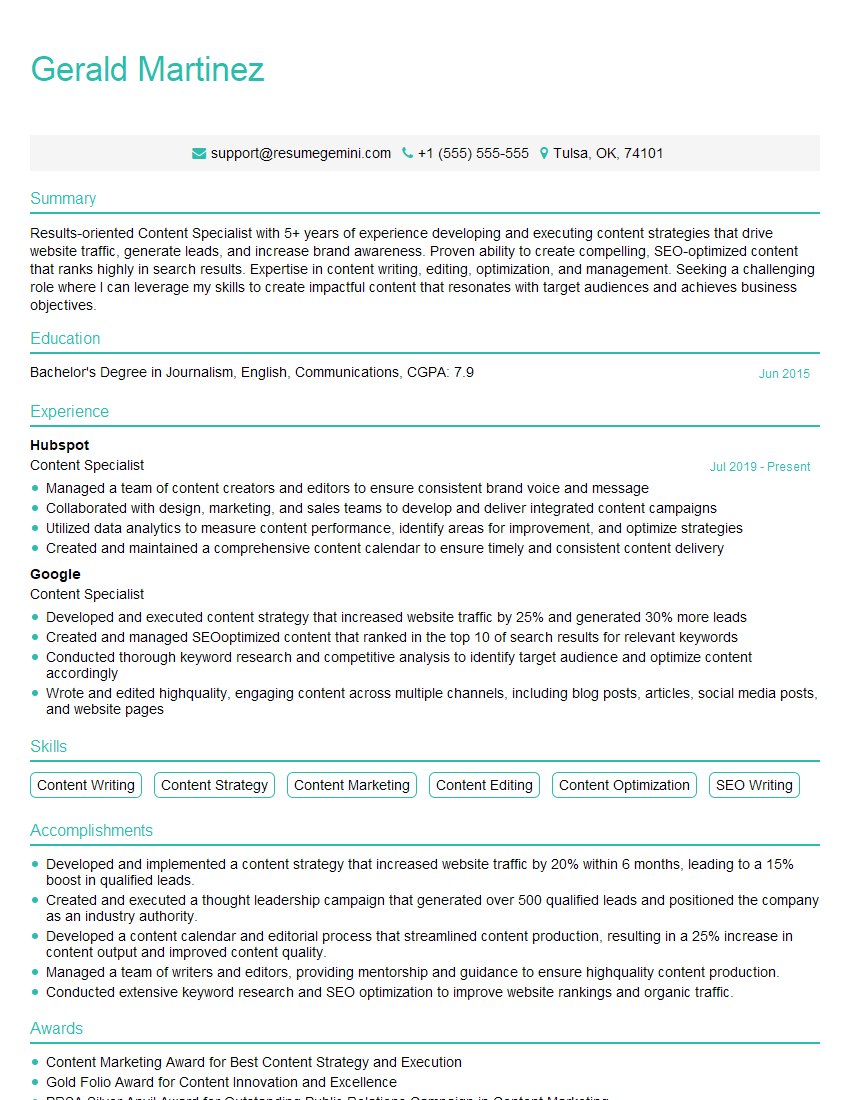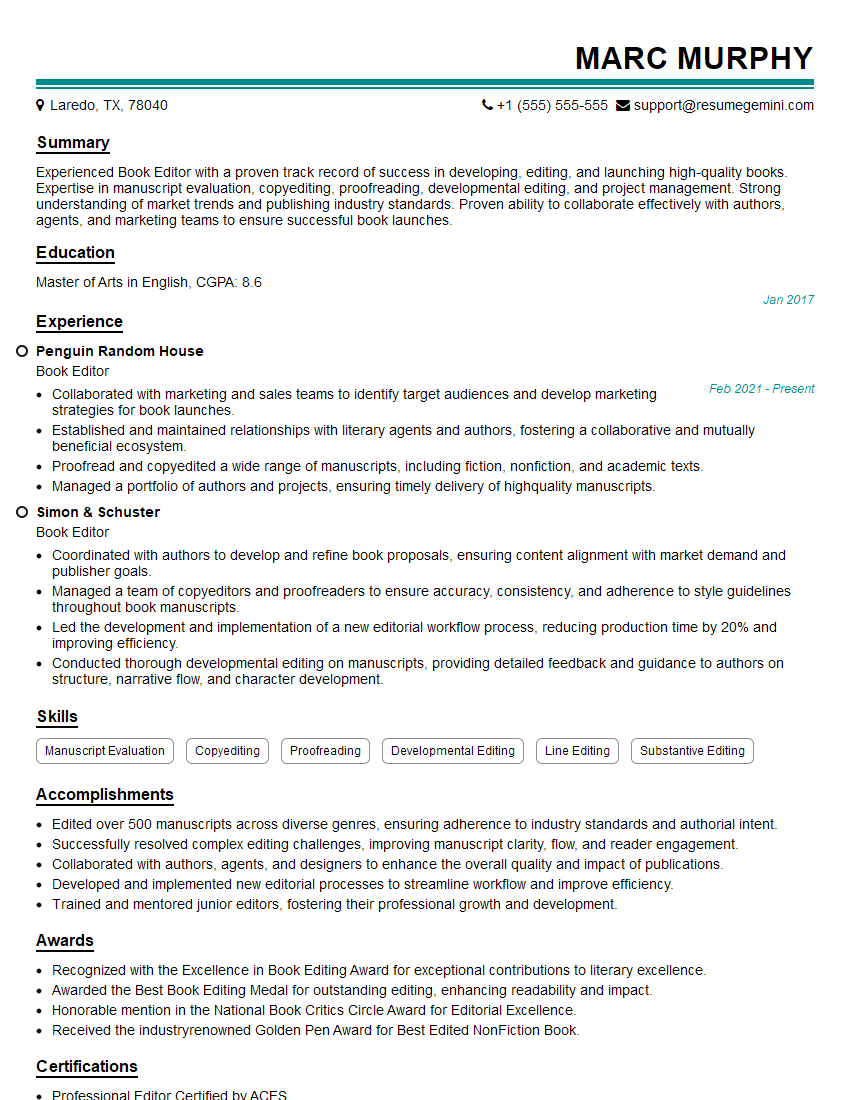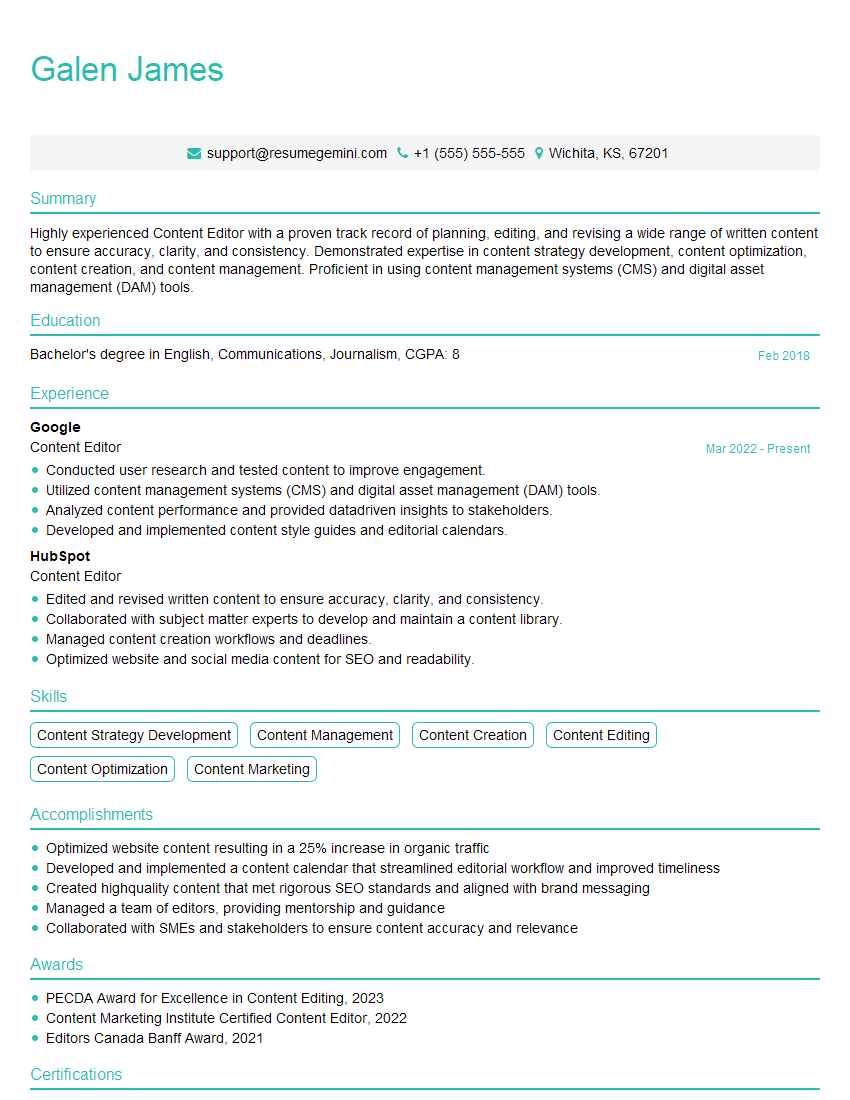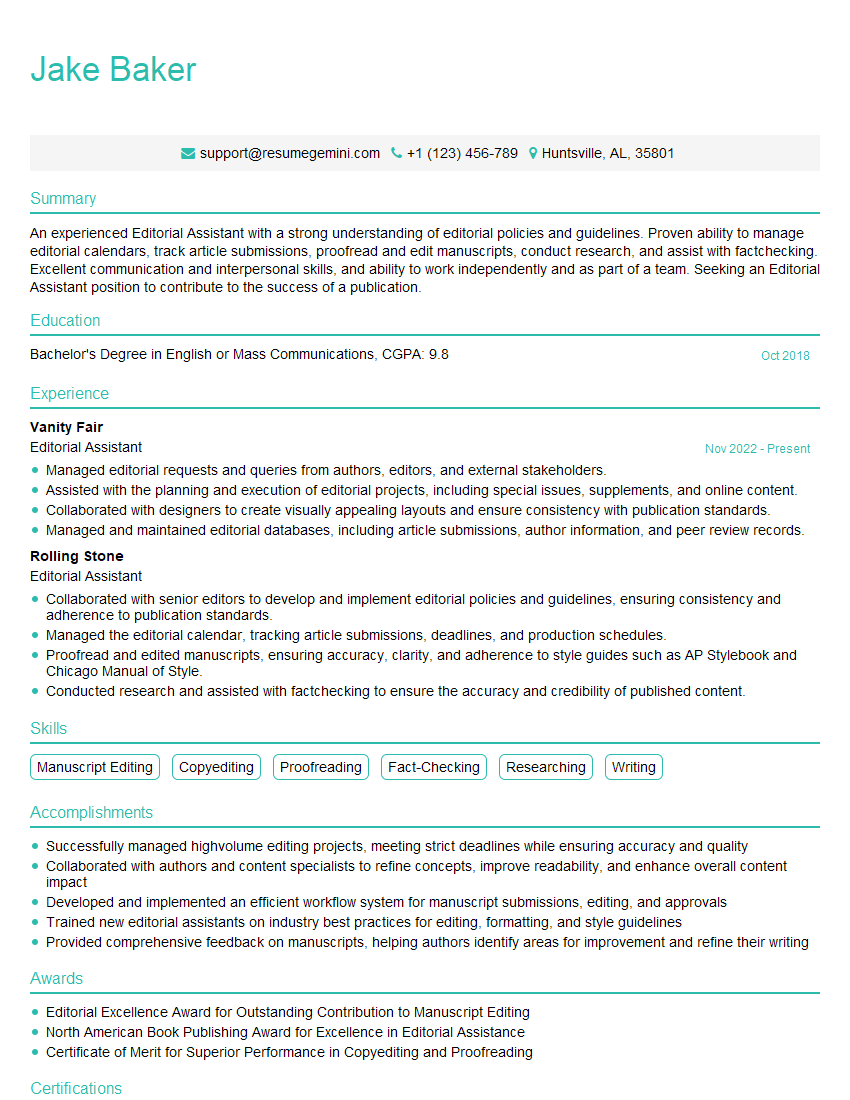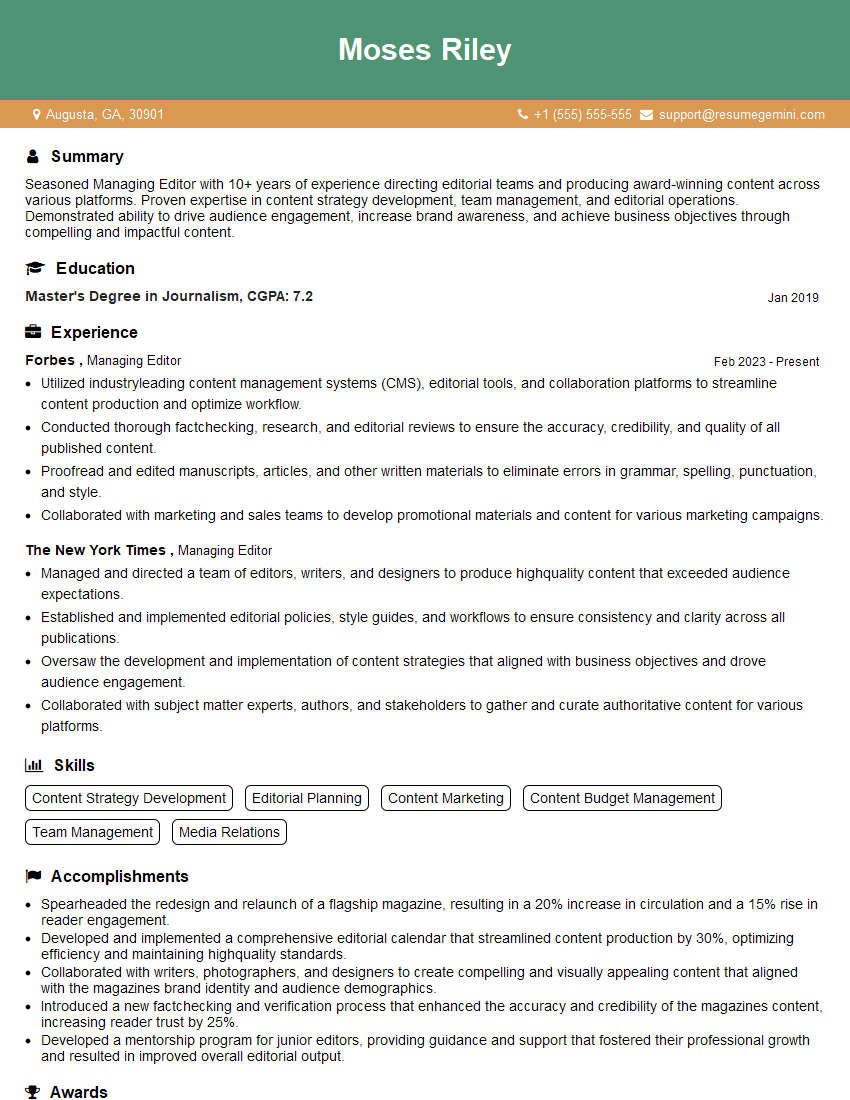Preparation is the key to success in any interview. In this post, we’ll explore crucial Copyediting and Proofreading interview questions and equip you with strategies to craft impactful answers. Whether you’re a beginner or a pro, these tips will elevate your preparation.
Questions Asked in Copyediting and Proofreading Interview
Q 1. What are the key differences between copyediting and proofreading?
Copyediting and proofreading are both crucial stages in the editing process, but they focus on different aspects. Think of copyediting as the ‘big picture’ edit and proofreading as the ‘final polish’.
- Copyediting is a substantive edit focusing on content, style, clarity, consistency, and accuracy. This includes checking for factual errors, improving sentence structure and flow, ensuring consistent tone and voice, and verifying the overall message aligns with the intended audience. It’s like a sculptor refining the shape of a clay figure.
- Proofreading is a surface-level edit focusing primarily on catching typos, grammatical errors, punctuation mistakes, and formatting inconsistencies. It’s the final check before publication, ensuring the manuscript is free from minor errors that could distract the reader. It’s akin to carefully dusting off the finished sculpture.
For example, a copyeditor might rewrite a convoluted sentence for clarity, while a proofreader would correct a misspelled word within that sentence.
Q 2. Explain your understanding of AP Style and Chicago Manual of Style.
AP Style (Associated Press Stylebook) and the Chicago Manual of Style are two prominent style guides, each with its own conventions. They dictate rules for everything from punctuation and capitalization to number style and citation formats. The choice depends heavily on the publication’s or organization’s preferences.
- AP Style is widely used in journalism and news writing. It prioritizes brevity, clarity, and consistency in news reporting. For example, AP Style uses numerals for numbers 10 and above (10 apples) and spells out numbers nine and below (nine apples). Dates are written as Month Day, Year (October 26, 2024).
- Chicago Manual of Style is more comprehensive and often used in academic writing, books, and scholarly publications. It offers detailed guidance on various aspects of writing and publishing, including extensive rules for citations and bibliographies (e.g., using footnotes or endnotes). Its approach to number style can be more flexible, sometimes preferring words for numbers under 100. Dates are typically written as Day Month Year (26 October 2024).
Choosing the right style guide is essential for maintaining consistency and professionalism in any piece of writing.
Q 3. How do you handle conflicting style guides within a single project?
Handling conflicting style guides requires careful planning and communication. The first step is to identify the primary style guide for the project and any exceptions needed. Clear communication with the client or editor about potential conflicts is key.
I typically create a style sheet that prioritizes one guide as the primary standard, and then explicitly lists any deviations or exceptions mandated by other guides or client preferences. This style sheet serves as a reference throughout the editing process. For instance, if a project predominantly follows AP Style but requires Chicago style for citations, the style sheet will clearly outline this discrepancy. This ensures that the edits are consistent and the style remains uniform despite the conflicting elements.
Documenting these exceptions is crucial; it helps ensure consistency and avoids confusion.
Q 4. Describe your process for proofreading a complex technical document.
Proofreading a complex technical document requires a methodical approach. It’s not just about scanning for errors; it’s about understanding the technical context.
- Understand the Subject Matter: Before beginning, I familiarize myself with any relevant terminology, concepts, and notations. This background helps identify potential inaccuracies.
- Multiple Passes: I typically conduct multiple passes, each focusing on a different aspect. One pass might concentrate on grammar and punctuation, another on technical accuracy, and a final pass on overall consistency and formatting. This reduces the chance of overlooking errors.
- Use Tools Effectively: I utilize tools like spell checkers and grammar checkers, but always remember they are not foolproof. I carefully review every flagged item.
- Read Aloud: Reading the document aloud, slowly, helps catch errors that the eyes might miss.
- Print a Copy: Proofreading on a printed copy often allows for better focus than working on a screen.
- Collaborate When Needed: For particularly complex documents, I might collaborate with subject matter experts to verify accuracy.
The goal is to not just catch typos, but to ensure the document is technically accurate and easily understood.
Q 5. How do you identify and correct grammatical errors, including subject-verb agreement and pronoun usage?
Identifying and correcting grammatical errors requires a keen eye and understanding of grammatical rules. Here’s how I approach it:
- Subject-Verb Agreement: I carefully check that the verb agrees in number with its subject. For example, ‘The
dogbarksloudly’ (singular subject, singular verb), but ‘Dogsbarkloudly’ (plural subject, plural verb). I watch out for intervening phrases that can obscure the true subject. - Pronoun Usage: I ensure pronouns have clear and unambiguous antecedents. For example, in ‘The
catsat on the mat, anditgroomed itself’, ‘it’ clearly refers to the cat. Vague pronoun usage leads to confusion; I correct them by clarifying the antecedent or replacing the pronoun. - Active Listening (While Reading): Reading aloud forces me to process every element of the sentence, increasing the likelihood of detecting grammatical inconsistencies.
I use a combination of rule application and a gut feeling—if a sentence sounds awkward, it usually needs improvement, regardless of whether a specific rule is broken.
Q 6. How do you ensure consistency in tone, style, and voice throughout a document?
Maintaining consistency in tone, style, and voice is essential for creating a cohesive and professional document. This involves:
- Developing a Style Guide: Early in the project, I collaborate with the client or editor to establish a clear style guide, outlining the desired tone (formal, informal, humorous, etc.), style (AP, Chicago, etc.), and voice (first-person, third-person, etc.).
- Consistent Terminology: I create a glossary of terms to ensure consistency in the use of technical jargon and specialized vocabulary.
- Multiple Reads for Consistency: I conduct multiple reads focusing specifically on tone, style, and voice, checking for inconsistencies or jarring shifts.
- Using Style Guides and Templates: Adherence to a particular style guide and the use of templates for formatting assist in maintaining consistency.
Imagine a novel; if the tone shifts wildly between chapters, it disrupts the reading experience. Consistency is key for readability and professionalism.
Q 7. What strategies do you use to find typos and inconsistencies efficiently?
Finding typos and inconsistencies efficiently involves a blend of technology and human expertise:
- Utilize Technology: Spell checkers and grammar checkers are useful but should be used judiciously. They can miss context-dependent errors and should not replace human judgment.
- Multiple Passes: I read the document multiple times, each focusing on a specific aspect: typos in one pass, punctuation in another, and consistency in the final pass.
- Change of Pace: After a long stretch, I take a break. This clears the mind and makes typos more apparent upon returning.
- Read Aloud (or Use Text-to-Speech): Reading aloud or using text-to-speech software changes the way you process the text and frequently uncovers errors.
- Print a Copy: This allows for a different reading perspective compared to screen reading.
- Use of Find and Replace (carefully!): For specific words or phrases where inconsistency is suspected, I use ‘Find and Replace’ to see how many times they appear. This helps identify discrepancies.
It’s a combination of technology, careful review, and mindful reading techniques that result in a polished, error-free document.
Q 8. How do you deal with ambiguous or unclear writing?
Ambiguous or unclear writing is a common challenge in copyediting and proofreading. My approach involves a multi-step process focused on understanding the author’s intent and clarifying the meaning for the reader. First, I carefully reread the ambiguous section multiple times, noting the specific phrases or sentences causing confusion. Then, I try to deduce the intended meaning by considering the surrounding context and the overall message of the piece. If the meaning remains unclear, I may consult reference materials or, if possible, contact the author or client for clarification. Finally, I rewrite the unclear passages, ensuring the new wording is precise, clear, and consistent with the overall tone and style of the document. For example, a sentence like “The dog chased the ball down the street, and it was red,” is unclear. Is the dog red, or the ball? My edit would clarify this, perhaps by rewriting it as “The dog chased the red ball down the street.” This ensures clarity and avoids any potential misinterpretations.
Q 9. How do you prioritize different types of errors when proofreading?
Prioritizing errors during proofreading is crucial for efficiency and impact. My approach follows a hierarchical system: First, I focus on critical errors that significantly affect the meaning or accuracy of the text. This includes factual inaccuracies, grammatical errors that alter the meaning (subject-verb disagreements causing significant confusion, incorrect use of homonyms that change meaning), and inconsistencies in style or formatting that impact readability. Next, I address significant grammatical errors that don’t alter meaning as drastically but still impact readability (run-on sentences, comma splices, etc.). Finally, I address minor errors such as typos, minor punctuation issues, and inconsistencies in style or formatting (if the larger issues have already been addressed). Think of it like triage in a hospital: life-threatening issues (major errors affecting meaning) come first, followed by serious injuries (grammatical errors affecting readability), and then minor issues (typos). This systematic approach ensures that the most important errors are corrected first, improving overall quality and minimizing the risk of misinterpretations.
Q 10. How familiar are you with different types of editing software?
I’m proficient in several editing software programs. My expertise includes Microsoft Word’s track changes feature, which is essential for collaborative editing. I also have experience with Adobe Acrobat Pro for PDF editing and markup, which is crucial for handling documents in their final format. Furthermore, I’m familiar with Grammarly and ProWritingAid, which offer automated grammar and style checks; however, I always review their suggestions carefully, recognizing the limitations of automated tools and using my editorial judgment to determine the most effective changes. I am also comfortable using specialized software for style guides like the Chicago Manual of Style or the Associated Press Stylebook, depending on the project’s needs.
Q 11. What’s your preferred method for tracking changes and revisions?
My preferred method for tracking changes and revisions is using the track changes feature in Microsoft Word. This allows me to clearly show all edits made, including additions, deletions, and formatting changes. This offers a clear audit trail, facilitating communication with clients or editors and simplifying the revision process. The ability to accept or reject changes individually provides granular control over the editing process. For PDF documents, Adobe Acrobat Pro’s commenting and markup tools serve a similar purpose, allowing me to highlight areas needing revision and add detailed comments directly onto the document. This ensures transparency and allows for easy collaboration and feedback integration.
Q 12. Describe a time you had to make a difficult editorial decision. What was your process?
In a recent project, I had to decide whether to maintain the author’s use of a potentially offensive term within a historical context. The author argued that maintaining the original wording accurately reflected the language used at the time. However, I felt its inclusion could be jarring or even upsetting to modern readers. My process involved careful consideration of the overall goals of the project, the target audience, and the potential impact of using or removing the term. I consulted style guides, relevant scholarly articles, and discussed the issue with the client. We agreed on a compromise: the term was retained, but a footnote was added providing context and acknowledging its potentially offensive nature. This allowed us to preserve historical accuracy while minimizing the risk of causing offense to modern readers. This decision exemplifies my commitment to balancing editorial accuracy with sensitivity and ethical considerations.
Q 13. How do you handle feedback and revisions from clients or editors?
I handle feedback and revisions by actively listening and carefully reviewing all comments. I approach each suggestion with an open mind, even if I initially disagree. My goal is to understand the reason behind each revision request. I then incorporate the feedback, clarifying any uncertainties with the client or editor before making changes. If I believe a change is unnecessary or detracts from the overall quality, I explain my reasoning clearly and professionally, offering alternative suggestions if applicable. Ultimately, collaboration is key; open communication and a shared understanding of the project goals are essential to ensure a successful outcome that meets both the client’s needs and the highest editorial standards. Clear and concise communication is paramount throughout this process.
Q 14. How do you maintain accuracy and efficiency under pressure?
Maintaining accuracy and efficiency under pressure requires a structured approach. I use time management techniques such as breaking down large projects into smaller, manageable tasks, setting realistic deadlines for each task, and prioritizing tasks based on importance and urgency. I create detailed checklists to ensure that nothing is overlooked. Regular breaks to prevent burnout are crucial for maintaining focus and accuracy. Additionally, I continuously refine my editing skills through ongoing professional development and familiarizing myself with new tools and techniques to maximize efficiency. In high-pressure situations, careful planning and organized workflow are vital for accuracy and meeting deadlines without sacrificing quality. Just like an athlete trains for peak performance, a professional editor needs to cultivate good habits and strategies to maintain their sharpness under pressure.
Q 15. How do you handle tight deadlines?
Tight deadlines are a reality in copyediting and proofreading. My approach is multifaceted and focuses on prioritizing tasks, efficient workflow, and clear communication. I begin by assessing the volume and complexity of the work, breaking it down into manageable chunks with realistic timeframes assigned to each. For instance, if I have a 5,000-word document due in 24 hours, I might allocate the first hour to a quick overall read for major issues, then dedicate blocks of time to specific sections, focusing on proofreading one section at a time before moving on. I utilize time-management techniques like the Pomodoro Technique (focused work periods followed by short breaks) to maintain concentration and prevent burnout. Open and proactive communication with clients is also vital; if I foresee potential delays, I inform them immediately, proposing solutions and adjusting expectations collaboratively.
I also leverage tools that increase efficiency, such as keyboard shortcuts for common editing functions, and utilize spell-check and grammar-check software as a first pass, although I always perform a thorough manual review after. Ultimately, successful deadline management hinges on a combination of organizational skills, effective time allocation, and open client communication.
Career Expert Tips:
- Ace those interviews! Prepare effectively by reviewing the Top 50 Most Common Interview Questions on ResumeGemini.
- Navigate your job search with confidence! Explore a wide range of Career Tips on ResumeGemini. Learn about common challenges and recommendations to overcome them.
- Craft the perfect resume! Master the Art of Resume Writing with ResumeGemini’s guide. Showcase your unique qualifications and achievements effectively.
- Don’t miss out on holiday savings! Build your dream resume with ResumeGemini’s ATS optimized templates.
Q 16. What is your approach to working with large volumes of text?
Handling large volumes of text requires a systematic and strategic approach. My process involves several key steps. First, I conduct a preliminary scan of the entire document to get a general sense of its style, tone, and potential issues. This helps me identify recurring errors or inconsistencies that can be addressed more efficiently later. Then, I break down the text into smaller, manageable sections, focusing on one section at a time to avoid getting overwhelmed. This might involve editing a chapter or a set number of pages at a time depending on the nature of the document.
I utilize track changes functionality in word processors to carefully document all edits made, ensuring easy review by clients or other stakeholders. For particularly lengthy projects, I might use a style guide or checklist to maintain consistency. Think of it like building a house – you don’t build the entire structure at once, you concentrate on one section at a time (foundation, walls, roof, etc.). Finally, a final review of the entire document is crucial to ensure consistency and catch any errors that might have been overlooked.
Q 17. What resources do you use to look up style, grammar, or usage questions?
My resource arsenal for style, grammar, and usage questions is extensive and constantly evolving. For style, I rely on established style guides like the Chicago Manual of Style, AP Stylebook, and MLA Handbook, choosing the appropriate guide based on the client’s requirements or the publication’s guidelines. For grammar and usage questions, I regularly consult reputable dictionaries such as Merriam-Webster and Oxford Dictionaries, alongside grammar guides like Garner’s Modern American Usage. Online resources like Grammarly (used cautiously for a second opinion, not as a primary tool) and the Purdue OWL (Online Writing Lab) are also valuable.
Beyond these resources, I maintain a personal style guide document for frequently encountered questions. I actively seek peer feedback and participate in professional development workshops to continually improve my knowledge and refine my approach. A good copyeditor is always learning and expanding their knowledge base.
Q 18. How do you manage multiple projects simultaneously?
Managing multiple projects efficiently requires meticulous organization and prioritization. I use project management tools like Trello or Asana to track tasks, deadlines, and client communication for each project. Each project gets its own dedicated space where I record deadlines, notes, client feedback, and progress updates. This keeps everything neatly organized and prevents projects from overlapping or getting confused.
I prioritize projects based on deadlines and client urgency, focusing on tasks with imminent deadlines first. I often time-block my day, allocating specific time slots for each project to avoid multitasking and maintain focus. Clear communication with clients is key, ensuring they understand my workload and anticipated turnaround times. Regularly reviewing my project schedule prevents surprises and allows for proactive adjustments as needed.
Q 19. Describe your experience with fact-checking and verification.
Fact-checking and verification are critical components of my work. My approach involves systematically verifying information using multiple reliable sources. For example, if a document mentions a specific statistic, I wouldn’t just accept it at face value. I would cross-reference it with at least two reputable sources – government websites, peer-reviewed journals, established news organizations, and credible data repositories. If there are discrepancies, I flag the issue for the client and propose solutions, perhaps suggesting alternative phrasing or providing additional context.
I am particularly vigilant with dates, names, places, and numerical data, checking these points meticulously against primary sources whenever possible. I maintain detailed notes about the sources used for each fact-check, providing a clear audit trail for transparency and accountability. This meticulous approach is crucial to ensure the accuracy and credibility of the final product. Remember, a single factual error can undermine the entire credibility of a piece of writing.
Q 20. How do you ensure the accessibility of edited content?
Ensuring the accessibility of edited content is a significant part of my responsibility. This encompasses several considerations: Firstly, I pay close attention to structural elements, ensuring proper heading levels (h1, h2, h3, etc.) and clear labeling of images and other media. I make sure all tables are properly formatted and include descriptive alt text for all images, enabling users of screen readers to understand the visual content. I avoid using color alone to convey information, instead pairing it with text descriptions or other cues.
Secondly, I prioritize plain language and concise phrasing, avoiding jargon and complex sentence structures that might be difficult to understand. I use tools like readability checkers to assess the complexity of the text and make improvements where necessary. Finally, I ensure the content adheres to WCAG (Web Content Accessibility Guidelines) standards, a set of guidelines for accessible web content. This involves checking for sufficient color contrast, appropriate font sizes, and providing captions for videos. Accessibility is not merely a good practice, it’s a fundamental aspect of creating content that is inclusive and reaches a wider audience.
Q 21. What are your strengths and weaknesses as a copyeditor/proofreader?
My strengths lie in my attention to detail, my meticulous approach to fact-checking, and my ability to adapt to different writing styles and client needs. I pride myself on my efficiency and my proactive communication style. For example, I recently edited a complex scientific paper with numerous technical terms. My knowledge of scientific style guides, coupled with my diligent fact-checking, resulted in a polished and accurate document that was readily accepted for publication. My strong organizational skills allow me to efficiently manage multiple projects concurrently, ensuring each receives the attention it deserves.
A weakness I’m actively working to improve is my tendency towards perfectionism. While striving for accuracy is paramount, sometimes the pursuit of absolute perfection can hinder the workflow. I am implementing strategies to balance meticulousness with timely delivery, focusing on prioritization and learning when to delegate or seek a second opinion to efficiently achieve a high quality outcome.
Q 22. What is your experience with different types of content (e.g., marketing materials, academic papers, technical documents)?
My experience spans a wide range of content types. I’ve worked extensively with marketing materials, from brochures and website copy to social media posts and email campaigns, ensuring brand consistency and compelling messaging. I’ve also handled academic papers, meticulously adhering to citation styles like MLA and APA, and ensuring clarity and precision in research-based writing. My technical writing experience includes documentation for software, manuals for equipment, and white papers, demanding a high level of accuracy and attention to detail to ensure the material is easily understood by a technical audience.
- Marketing: I’ve improved click-through rates on marketing emails by refining subject lines and calls to action.
- Academic: I’ve helped graduate students refine their theses, ensuring grammatical accuracy and consistent formatting.
- Technical: I’ve clarified complex technical concepts in user manuals to improve user experience and reduce support requests.
Q 23. How do you stay updated on grammar rules and style guide changes?
Staying current in the ever-evolving world of grammar and style is crucial. I subscribe to reputable style guides like The Chicago Manual of Style and The Associated Press Stylebook, regularly reviewing updates and changes. I also follow leading grammar experts and organizations like the American Copy Editors Society (ACES) through their publications, webinars, and online forums. Attending professional development workshops and conferences further enhances my knowledge and keeps me abreast of best practices. Think of it like a chef constantly refining their techniques – staying updated is essential to delivering top-quality work.
Q 24. Explain your experience with using style guides like MLA or APA.
I’m proficient in both MLA and APA styles, having used them repeatedly in my work with academic papers and research articles. My experience includes formatting in-text citations, creating accurate reference lists, and ensuring consistency in headings, spacing, and other formatting elements. For instance, I’ve worked on several dissertations where precise adherence to APA style was critical for publication. The key is not just knowing the rules but understanding the underlying principles – why certain formatting choices are made – which allows me to adapt to nuanced requirements within each style guide.
Q 25. Describe your experience with collaborating with other editors or writers.
Collaboration is key in my workflow. I’ve worked closely with other editors to ensure consistency across multiple documents and projects. I’ve also collaborated extensively with writers, offering constructive feedback and suggestions to improve their work. Effective communication is paramount; I use clear and concise feedback to facilitate efficient revisions. I believe in a collaborative approach, where we work together to reach a shared understanding of the project’s goals and produce high-quality results. One successful project involved a team of five, where we created a consistent style guide for a large company’s intranet – a testament to the importance of collaboration.
Q 26. What are your salary expectations for this role?
My salary expectations for this role are between $X and $Y per year, depending on the specifics of the position and benefits package. This range is based on my experience, skills, and the current market rate for similar roles.
Q 27. Do you have experience with using CAT tools or other software for editing?
Yes, I have experience using CAT tools (Computer-Assisted Translation tools), such as SDL Trados Studio and memoQ. These tools streamline the editing process, particularly for large projects with consistent terminology. They allow for efficient translation memory management, quality assurance, and improved consistency across multiple documents. I also have experience with other editing software, including Microsoft Word’s track changes feature and Adobe Acrobat for PDF editing. I am adept at leveraging technology to enhance efficiency and accuracy in my work.
Q 28. Are you familiar with different types of punctuation and their correct usage?
Yes, I am very familiar with various punctuation marks and their correct usage. My understanding extends beyond basic rules to nuanced applications, such as the correct use of semicolons, colons, dashes, ellipses, and quotation marks in various contexts. For example, I understand the difference between an em dash (—) and an en dash (–), and I know when to use a semicolon to connect closely related independent clauses. Incorrect punctuation can significantly impact clarity and meaning, so I am meticulous in my attention to detail in this area. I see punctuation as the subtle art of breathing life into writing, creating flow and precision for the reader.
Key Topics to Learn for Copyediting and Proofreading Interview
- Grammar and Mechanics: Mastering grammar rules, punctuation, and style guides (e.g., AP, Chicago) is fundamental. Practice identifying and correcting grammatical errors, ensuring consistent usage of tense and voice.
- Style and Tone: Understand how to adapt writing style to different audiences and purposes. Practice analyzing text for clarity, consistency, and appropriateness of tone. Consider how subtle changes can impact the overall message.
- Fact-Checking and Verification: Learn effective strategies for verifying facts and figures, ensuring accuracy and credibility in your edits. Develop a process for researching and confirming information from reputable sources.
- Structural Editing: Practice identifying and improving the overall structure and organization of text. This includes evaluating logical flow, paragraphing, and transitions between ideas. Be prepared to discuss examples of improving readability and coherence.
- Proofreading Techniques: Develop efficient proofreading strategies to catch errors you might miss during initial editing. Explore techniques such as using different reading speeds and approaches to thoroughly review text.
- Understanding Style Guides: Demonstrate familiarity with various style guides (AP, Chicago, etc.) and their specific requirements. Be prepared to discuss the nuances of different styles and how they impact editing choices.
- Software Proficiency: Highlight your skills in relevant software like MS Word, Google Docs, or specialized editing programs. Be ready to discuss your experience with track changes, comments, and other collaborative features.
- Ethical Considerations: Discuss your understanding of ethical practices in editing, including plagiarism detection and attribution. Be prepared to answer questions about maintaining integrity and accuracy in your work.
Next Steps
Mastering copyediting and proofreading opens doors to diverse and rewarding career paths in publishing, journalism, marketing, and more. These skills are highly valued, demonstrating attention to detail, strong communication abilities, and a commitment to accuracy. To maximize your job prospects, creating an ATS-friendly resume is crucial. ResumeGemini is a trusted resource to help you build a compelling and effective resume that highlights your skills and experience. ResumeGemini provides examples of resumes tailored to Copyediting and Proofreading roles, offering invaluable guidance to help you present yourself in the best possible light to potential employers. Take advantage of these resources to elevate your job search and secure your ideal position.
Explore more articles
Users Rating of Our Blogs
Share Your Experience
We value your feedback! Please rate our content and share your thoughts (optional).
What Readers Say About Our Blog
Hi, I’m Jay, we have a few potential clients that are interested in your services, thought you might be a good fit. I’d love to talk about the details, when do you have time to talk?
Best,
Jay
Founder | CEO
